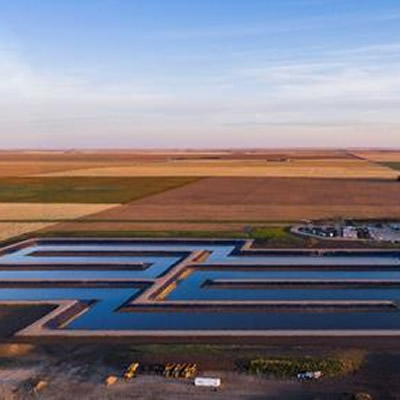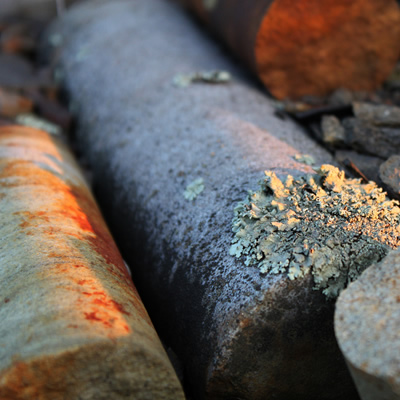Signs of diamonds detected in the western Athabasca Basin
The western Athabasca Basin has seen a rush to the potentially diamond-rich area.
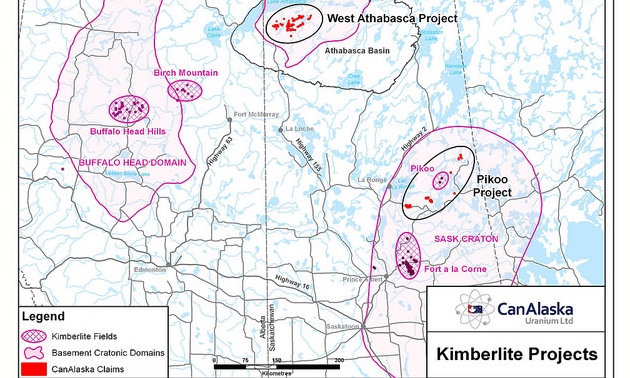
CanAlaska's diamond claims are delineated in the western Athabasca Basin. — Photo courtesy Sean Bosman
CanAlaska has detected what appear to be kimberlites in the Athabasca basin.
Until now, this extreme western area of Saskatchewan’s Athabasca basin has been ignored for exploration because of the thickness of the sandstone, which ranges from 1,000 metres to 1,500 metres in depth.
Peter Dasler, president and CEO of CanAlaska, is excited to share the findings with the public. “The diamond story is very fascinating,” he said. “As a geologist, I like the idea of looking for these kimberlite pipes that come up from depths of 150 to 200 kilometres through the Earth’s crust and bring diamonds to the surface.”
The area fits the mould for diamond deposits. “We have a very thick piece of continental crust under that part of Athabasca,” Dasler said. “It’s covered with a lot of sandstone, but we think that the targets we are seeing are kimberlite pipes coming right through the sandstone layers. Nearby in Alberta there are diamond-bearing kimberlite pipes and they are younger than the Athabasca sandstone, so we think what we are seeing is also younger and therefore would have come to surface.”
The Saskatchewan provincial government completed a survey of the area back in 2011, but nothing related to diamonds came of it. CanAlaska’s geologist, Karl Schimann, however, saw some irregular features, so he had the company's geophysicist further process the data. This processing uncovered clusters of “magnetic anomalies” similar in character to known kimberlites, which are host rocks for the majority of diamond deposits. CanAlaska narrowed the list down to 75 promising targets and staked claims to cover these.
Dasler’s team hopes that the public understands the sheer size of the potential kimberlite field. Dasler draws attention to the density of diamond indicators in the area just down-ice, north of Fort McMurray. The source of these has not been determined, but these Athabasca targets are a possibility. “When we look at the number of targets—we’ve staked 75 targets between 200 and 500 metres in diameter—having the right crustal rocks underneath, the clustering makes the area look like a kimberlite field.”
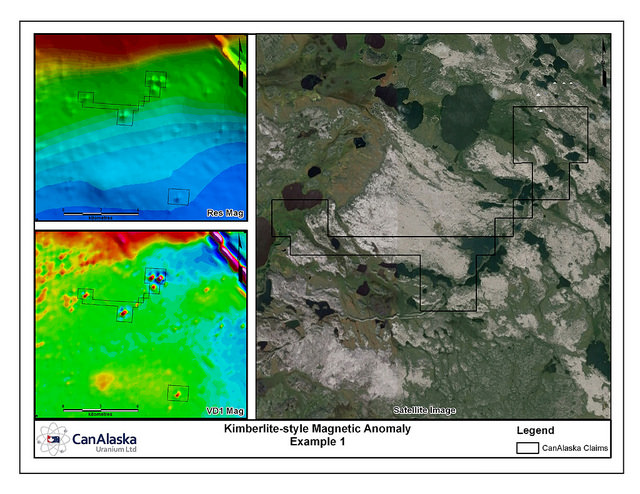
Saskatchewan geologists had surveyed the land where CanAlaska found the kimberlite field. — Photo courtesy Sean Bosman
“It wasn’t until when we started processing some of the Saskatchewan government’s new airborne geophysical surveys in 2012 that we saw little circular features that looked like they could be kimberlite pipes," Dasler said. "When you look at everything together, this area of Athabasca has underlying thick continental crust, cut by major deep faults.”
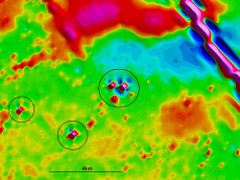
CanAlaska detected magnetic anomalies that signify Kimberlite pipes. — Photo courtesy Sean Bosman
Canada is already a source of diamonds. Just north of the Athabasca site in question are the Ekati and Diavik areas in the Slave Craton. These diamond-bearing areas have similar crustal thicknesses as the Rae Craton, which extends into the area where CanAlaska located the kimberlite targets.
The past few months have seen a rush to the potentially diamond-rich site. CanAlaska, however, chooses to focus on uranium rather than diamonds. While the company has attained a large portion of land in this area, it is currently in search of partnerships that would take over the exploration for diamonds.
Exploration should be straight-forward and relatively easy. “There should be indications very near the surface. We should be able to sample the surface and start seeing rock fragments and any indicator minerals as we work through the project this summer,” said Dasler. "We expect there will be several teams on the ground this summer looking for those kimberlite pipes that we think exist in that area.”
Dasler’s team at CanAlaska believes that Athabasca will be an easy project. “Nobody has been looking for uranium there because they think that the sandstone is too thick, so not too many geologists have walked over the area looking for something like this,” Dasler said. Between the almost untouched land and legitimate data from recent surveys, this is an exciting project.
“Now we have the airborne survey that pinpoints where these targets are to within a few metres. When we get out there, we will rapidly focus on the target areas and be able to sample any indicator minerals down-ice.”
Athabasca is definitely a promising site for a diamond discovery. “The really good thing about this is that it fits most of the geological requirements for us to be looking for diamonds,” he explained, “with the thick continental crust and the area that people haven’t been working.” Better yet, it’s relatively easy to access, having a good road to the area and winter trails, plus there are nearby airstrips and a former mining operation just to the south at Cluff Lake.
The existing mines in the Athabasca basin help the local communities as well. “We’ve seen a big increase in the standard of education in the North [of Saskatchewan] and a big increase in personal wealth from the uranium mining and operations,” said Dasler. “These are very rich mines. They provide a lot of employment and look after the communities very well. A diamond discovery would be icing on the cake.”

